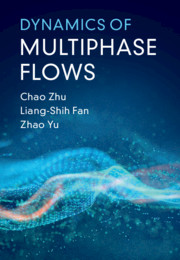Book contents
- Frontmatter
- Dedication
- Contents
- Preface
- Part I Principles
- 1 Introduction to Multiphase Flows
- 2 Continuum Modeling of Single-Phase Flows
- 3 Transport of Isolated Objects: Solid Particles, Droplets, and Bubbles
- 4 Interactions of Particles, Droplets, and Bubbles
- 5 Continuum-Discrete Tracking Modeling of Multiphase Flows
- 6 Continuum Modeling of Multiphase Flows
- 7 Numerical Modeling and Simulation
- 8 Measurement Techniques
- Part II Application-Based Analysis of Multiphase Flows
- Index
5 - Continuum-Discrete Tracking Modeling of Multiphase Flows
from Part I - Principles
Published online by Cambridge University Press: 10 September 2021
- Frontmatter
- Dedication
- Contents
- Preface
- Part I Principles
- 1 Introduction to Multiphase Flows
- 2 Continuum Modeling of Single-Phase Flows
- 3 Transport of Isolated Objects: Solid Particles, Droplets, and Bubbles
- 4 Interactions of Particles, Droplets, and Bubbles
- 5 Continuum-Discrete Tracking Modeling of Multiphase Flows
- 6 Continuum Modeling of Multiphase Flows
- 7 Numerical Modeling and Simulation
- 8 Measurement Techniques
- Part II Application-Based Analysis of Multiphase Flows
- Index
Summary
Chapter 5 delineates the Eulerian–Lagrangian modeling commonly used for dilute-phase multiphase flows. The most essential part is the formulation of a Lagrangian trajectory model to describe the transport of individual particles, which requires proper formulation of particle–fluid and particle–particle interactions involved. The basic modeling considerations include the type of Lagrangian trajectory models such as deterministic trajectory model, stochastic trajectory model, particle-cloud tracking model, or discrete element method; the degree of phase coupling between Lagrangian models of discrete phases and Eulerian model of continuum phase such as one-way or two-way particle–fluid coupling or four-way particle–fluid and particle–particle coupling flow; the field coupling with particle transport such as the electrostatic field induced by the suspended charged particles or thermal radiation among particles; and the turbulence modulation between particles and eddy transport. The Lagrangian model of particle motion, typically in a simplified form of additivity of individual modes of fluid–particle interactions, is employed in the Lagrangian modeling of discrete phase transport.
Keywords
- Type
- Chapter
- Information
- Dynamics of Multiphase Flows , pp. 172 - 211Publisher: Cambridge University PressPrint publication year: 2021



